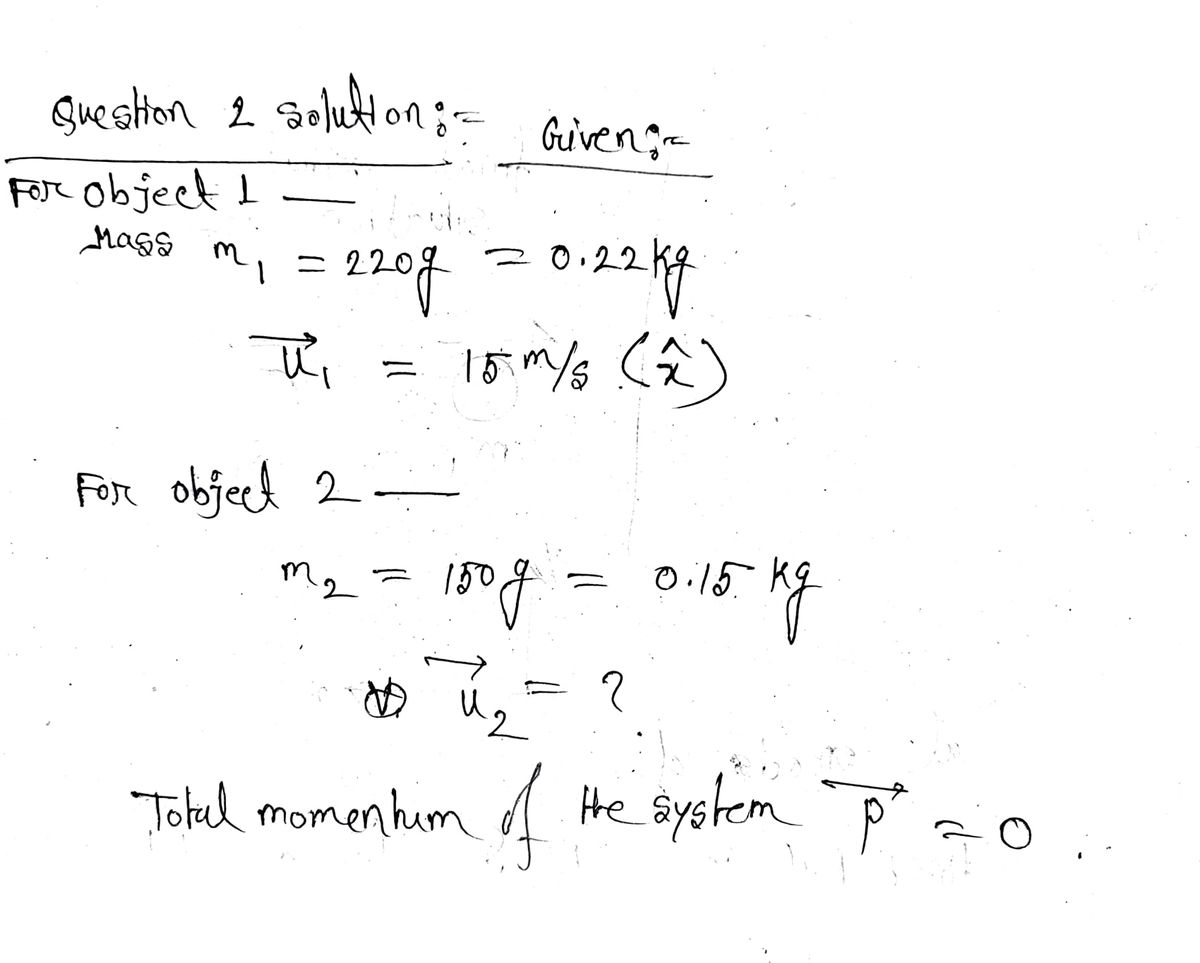2. A system contains two objects. Object 1 has a mass of 220 g and is moving with a velocity (15 m/s). Object 2 has a mass of 150 g. What must the velocity of object 2 be for the total system momentum to be zero? 3. Express the vector A = 41 m/s @ - -47° in terms of its components.
2. A system contains two objects. Object 1 has a mass of 220 g and is moving with a velocity (15 m/s). Object 2 has a mass of 150 g. What must the velocity of object 2 be for the total system momentum to be zero? 3. Express the vector A = 41 m/s @ - -47° in terms of its components.
College Physics
11th Edition
ISBN:9781305952300
Author:Raymond A. Serway, Chris Vuille
Publisher:Raymond A. Serway, Chris Vuille
Chapter1: Units, Trigonometry. And Vectors
Section: Chapter Questions
Problem 1CQ: Estimate the order of magnitude of the length, in meters, of each of the following; (a) a mouse, (b)...
Related questions
Topic Video
Question
I need help with questions 2 and 3?

Transcribed Image Text:Questions
1. (a) What does it mean to say that momentum is a conserved quantity?
(b) Under what circumstance(s) will the change in momentum of a system be zero?
2. A system contains two objects. Object 1 has a mass of 220 g and is moving with a velocity
(15 m/s). Object 2 has a mass of 150 g. What must the velocity of object 2 be for the total
system momentum to be zero?
3. Express the vector A = 41 m/s @ -47° in terms of its components.
4. If they are sensible computations, complete the calculations given below. If the requested
calculation does not make sense, explain what makes it nonsense.
(a)
21 kg
14 kg
-
-12 m/s
22 m/s
7. Two carts collide on a level, frictionless track.
Just before they collide, the 370 g cart had a
velocity of 1.7 m/s & and the 600 g cart had a
velocity of -1.7 m/s. If they stick together,
what will their velocity be just after the colli-
sion?
(b) 6.0s
8. The motion of an object along a horizontal
surface is described by the motion diagram in
part (a) of the figure to the right. Which of
the three graphs below that motion diagram is
the most correct representation of the velocity
of the object? Explain your choice.
5. Sketch a graph of velocity as a function of time for an object that is located at x = 3m
at t = 0 and is moving at a constant velocity of (-2.0 m/s) Make sure to label your axes,
including appropriate scales and units to show at least 4 seconds of time.
6. Similarly, sketch a graph of position as a function of time for the object in question 5.
(a)
4₁ = 0
x₁ = 0
V₁ = 0
4.0 m/s
-8.0 m/s
(b)
>t
+
(c)
-22 m
46 m
>t
(d)
L
>t

Transcribed Image Text:Review of formulas
Ar V
A7 = avg At (how far, how fast, how long)
P = mv
K = = -mv²
ΔΡ
F = =P or F = 47
dt
At
V Eb = VES + V sb
Es
V Eb = VbE
7cm=
V
cm
m₁ř₁ + m₂ ₂ +...
m₁ + m₂ + ...
=
P tot
mtot
m₁v₁ + m₂ √₂+...
m2 2
1
m₁ + m₂ + ...
P final = Pinitial + AP in - A Pout
Isolated system
• Ptoti = P totf
m₁v1 + m₂ V2 = ₁1f + m₂ ²
2f
li
●
e = -
Vif - V2f
Vli - V2i
2
Knoncony == mtot vem
=
Kconv=Ktot-mtot vem
2
Ptot
2mtot
Expert Solution
Step 1: Question 2 solution:
Given information:
Step by step
Solved in 3 steps with 3 images

Knowledge Booster
Learn more about
Need a deep-dive on the concept behind this application? Look no further. Learn more about this topic, physics and related others by exploring similar questions and additional content below.Recommended textbooks for you

College Physics
Physics
ISBN:
9781305952300
Author:
Raymond A. Serway, Chris Vuille
Publisher:
Cengage Learning

University Physics (14th Edition)
Physics
ISBN:
9780133969290
Author:
Hugh D. Young, Roger A. Freedman
Publisher:
PEARSON

Introduction To Quantum Mechanics
Physics
ISBN:
9781107189638
Author:
Griffiths, David J., Schroeter, Darrell F.
Publisher:
Cambridge University Press

College Physics
Physics
ISBN:
9781305952300
Author:
Raymond A. Serway, Chris Vuille
Publisher:
Cengage Learning

University Physics (14th Edition)
Physics
ISBN:
9780133969290
Author:
Hugh D. Young, Roger A. Freedman
Publisher:
PEARSON

Introduction To Quantum Mechanics
Physics
ISBN:
9781107189638
Author:
Griffiths, David J., Schroeter, Darrell F.
Publisher:
Cambridge University Press

Physics for Scientists and Engineers
Physics
ISBN:
9781337553278
Author:
Raymond A. Serway, John W. Jewett
Publisher:
Cengage Learning

Lecture- Tutorials for Introductory Astronomy
Physics
ISBN:
9780321820464
Author:
Edward E. Prather, Tim P. Slater, Jeff P. Adams, Gina Brissenden
Publisher:
Addison-Wesley

College Physics: A Strategic Approach (4th Editio…
Physics
ISBN:
9780134609034
Author:
Randall D. Knight (Professor Emeritus), Brian Jones, Stuart Field
Publisher:
PEARSON